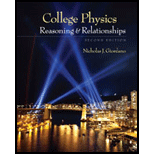
Concept explainers
(a)
The speed of the ball at time
(a)
Answer to Problem 27P
The speed of the ball at time
Explanation of Solution
Write the expression for horizontal component of speed.
Here,
Write the expression for vertical component of speed.
Here,
Write the expression for magnitude of speed.
Here,
Conclusion:
Substitute
Substitute
Substitute
Therefore, the speed of the ball at time
(b)
The angle
(b)
Answer to Problem 27P
The angle
Explanation of Solution
Write the expression for angle
Rearrange the above equation.
Conclusion:
Substitute
Therefore, the angle
(c)
The value of time
(c)
Answer to Problem 27P
The value of time
Explanation of Solution
Write the expression for vertical component of speed.
Here,
Rearrange the above equation, to find
Conclusion:
Substitute
Therefore, The value of time
Want to see more full solutions like this?
Chapter 4 Solutions
College Physics
- If a projectile is fired from the origin of the coordinate system with an initial velocity υ0 and in a direction making an angle α with the horizontal, calculate the time required for the projectile to cross a line passing through the origin and making an angle β < α with the horizontal.arrow_forwardA string attached to an airborne kite is maintained at an angle of 40 ° with the horizontal. If a total of 120 m of string is reeled in while bringing the kite back to the ground, what is the horizontal displacement of the kite in the process? (Assume the kite string doesn’t sag.) a.100 m b.92 m c.84 m d.77 marrow_forwardIf a baseball is hit with a vertical speed of 30 m/s and a horizontal speed of 2 m/s, how long will the ball remain in the air? (Assume for the purposes of this question that the ball starts at nearly ground level.) How far will it go?arrow_forward
- A projectile is fired vertically upward with a given initial velocity. It reaches a maximum height of 100 m. If the same projectile is fired again with double the initial velocity. The projectile will reach a maximum height of a) 70.7 m b) 141.4 m c) 200 m d) 241 m e) 400 marrow_forwardA cannonball is fired at an angle above the ground. Which of the following is/are true? a. The horizontal velocity of the cannonball remains constant. b. The vertical velocity of the cannonball increases. c. The horizontal velocity of the cannonball decreases. d. The vertical velocity of the cannonball remains constant.arrow_forwardA javelin thrower standing at rest holds the center of the javelin behind her head, then accelerates it through a distance of 70 cm as she throws. She releases the javelin 2.0 m above the ground traveling at an angle of 30 degrees above the horizontal. Top-rated javelin throwers do throw at about a 30 degree angle, not the 45 degree you might have expected, because the biomechanics of the arm allow them to throw the javelin much faster at 30 degrees than they would be able to at 45 degrees . In this throw, the javelin hits the ground 64 m away. What was the acceleration of the javelin during the throw? Assume that it has a constant acceleration.arrow_forward
- A javelin thrower standing at rest holds the center of the javelin behind her head, then accelerates it through a distance of 70 cm as she throws. She releases the javelin 2.0 m above the ground traveling at an angle of 30 degrees above the horizontal. Top-rated javelin throwers do throw at about a 30 degree angle, not the 45 degree you might have expected, because the biomechanics of the arm allow them to throw the javelin much faster at 30 degree than they would be able to at 45 degree. In this throw, the javelin hits the ground 59 m away.arrow_forwardIn Fig, a slab of mass m1 =40 kg rests on a frictionless floor, and a block of mass m2 =10kg rests on top of the slab. Between block and slab, the coefficient of static friction is 0.60, and the coefficient of kinetic friction is 0.40. A horizontal force of magnitude 100 N begins to pull directly on the block, as shown. In unit-vector notation, what are the resulting accelerations of (a) the block and (b) the slab?arrow_forwardThe height of a basketball hoop is 3.05 m and the distance between the hoop and the free throw line is 4.57 m. If a 1.90 m tall person shoots the ball from the free throw line at an angle of 54.0° with respect to the horizontal, at what speed should the ball leave his hands?arrow_forward
- A boy wishes to throw a ball over a flat roofed school house that stands 12 m wide and 7.5 m high on level ground. Assuming that the ball will leave his hand at a height of 5 m above the ground,determine how far from the wall he should take his hand in order to make the ball clear the roof with least effort, that is, with minimum velocity.arrow_forwardThe left motor draws in the cable at C with a constant velocity of 4 m/s. If the velocity of crate B relative to crate A is 1 m/s upward, what is the velocity of portion D of the cable being reeled in by the right motor?arrow_forwardThe standard height of a basketball hoop is 3.05 m and the standarddistance between the hoop and the free throw line is 4.57 m. If a 1.90 m tall Stephen Curry shoots the ball from the free throw line at an angle of 54.0 degrees with respect to the horizontal, at what speed should the ball leave his hands?arrow_forward
 Classical Dynamics of Particles and SystemsPhysicsISBN:9780534408961Author:Stephen T. Thornton, Jerry B. MarionPublisher:Cengage Learning
Classical Dynamics of Particles and SystemsPhysicsISBN:9780534408961Author:Stephen T. Thornton, Jerry B. MarionPublisher:Cengage Learning
